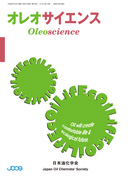
- |<
- <
- 1
- >
- >|
-
Kensuke NAKA2017Volume 17Issue 5 Pages 203-210
Published: 2017
Released on J-STAGE: August 05, 2019
JOURNAL FREE ACCESSOctakis(propenyl succinicanhydrido)polyhedral octasilicate (OS-SA), which is prepared by hydrosilylation of octadimethylsiloxy-polyhedral octasilicate with propenyl succinic anhydride, is an attractive intermediate to produce a variety of octasilicate (OS)-cored dendrimers. The OS-core dendrimers are ideal candidates for single component functional solid-state materials, which possess three-dimensional well-defined molecular level structures. As these dendrimers have globular conformations due to the rigid OS core, their three-dimensional structures are maintained in the solid state. Especially, terminal function groups are isolated and inhibit interaction with neighboring branches. This review focuses on recent efforts to prepare single component functional solid-state materials based on the OS-core dendrimers. The OS-cored dendrimers bearing biphenyl or carbazole units on their terminal groups formed thermoplastic transparent free-standing films at room temperature. Bi-functional terminal OS-cored dendrimers bearing carbazole and 1,8-naphthalimide or fluorocarbon and hydrocarbon chains on their peripheries were synthesized by combination of ring-opening and condensation reaction of OS-SA with 9H-carbazole-9-ethanol and N-(2-hydroxyethyl)-1,8-naphthalimide or 9-decanol and perfluoro-1-decanol, respectively. The bi-functional terminal OS-cored dendrimers showed not only individual properties of the functional units but new functions derived from interaction between the two units.
View full abstractDownload PDF (1575K) -
Yosuke SUGIMOTO, Tooru OOYA2017Volume 17Issue 5 Pages 211-216
Published: 2017
Released on J-STAGE: August 05, 2019
JOURNAL FREE ACCESSPolyglycerol dendrimers (PGD) and hyperbranched polyglycerols (HPG) are known as biocompatible and hydrophilic soft materials as well as poly(ethylene glycol) (PEG). However, the branched effect of PGD and HPG on bio-related functions is still unknown. In this review, recent progress of the research on PGD and HPG was introduced in the view points of both the basic characteristics and the bio-related applications. Hydrophobic character of PGD in water was analyzed by using a fluorescent probe, and PGD was found to provide less polar microenvironment than the aqueous environment. We also demonstrated the interaction between various guest molecules bearing amino groups and PGD and HPG, suggesting that both molecules bear good potentials as guest molecule-selective host molecules. In addition, protein interaction between PGD and some proteins were enhanced by the hydrophobic character of PGD. The PGD and HPG are believed to be developed toward industrial applications due to the unique chemical and biological functions.
View full abstractDownload PDF (631K)
-
Michihiro SUGANO2017Volume 17Issue 5 Pages 217-222
Published: 2017
Released on J-STAGE: August 05, 2019
JOURNAL FREE ACCESSRecently, Hibino has reviewed bioactivity of choline in the February issue of this journal1). This review helps serve collective comprehension of the related filed of choline bioactivity, but the information regarding the trimethylamine-N-oxide (TMAO), a well-known metabolite of choline with the plausible atherogenic potential, is not introduced. TMAO is a crucial compound to recognize the safety aspects of choline consumption. A portion of choline ingested is converted by gut bacteria to trimethylamine (TMA), which is then absorbed from the intestine and transported to the liver, where it is enzymatically converted to TMAO. As phsophatidylcholine (PC), the major dietary source of choline, is known to be antiatherogenic, the situation is really complicated. Egg is a major source of choline as PC (L type, 147 mg) and consumption of less than 2 eggs per day may not increase the blood level of TMAO, though not conclusive. Involvement of gut microbes is one of the recent exciting topics concerning the cognitive role of choline.
View full abstractDownload PDF (829K)
- |<
- <
- 1
- >
- >|